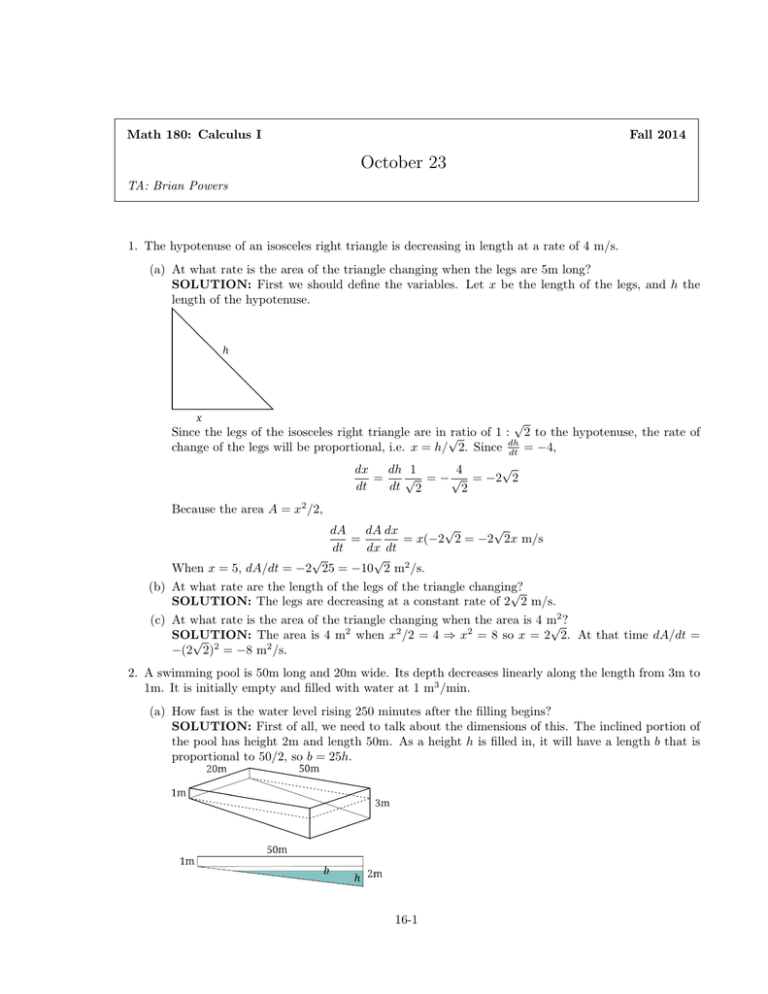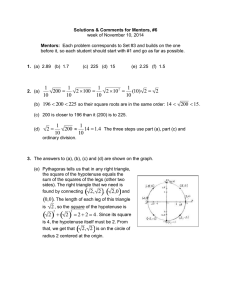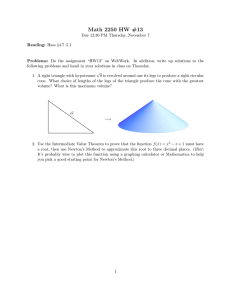Solutions
advertisement

Math 180: Calculus I Fall 2014 October 23 TA: Brian Powers 1. The hypotenuse of an isosceles right triangle is decreasing in length at a rate of 4 m/s. (a) At what rate is the area of the triangle changing when the legs are 5m long? SOLUTION: First we should define the variables. Let x be the length of the legs, and h the length of the hypotenuse. √ Since the legs of the isosceles right triangle are in √ ratio of 1 : 2 to the hypotenuse, the rate of change of the legs will be proportional, i.e. x = h/ 2. Since dh dt = −4, √ dx dh 1 4 √ = − √ = −2 2 = dt dt 2 2 Because the area A = x2 /2, √ √ dA dA dx = = x(−2 2 = −2 2x m/s dt dx dt √ √ When x = 5, dA/dt = −2 25 = −10 2 m2 /s. (b) At what rate are the length of the legs of the triangle changing? √ SOLUTION: The legs are decreasing at a constant rate of 2 2 m/s. 2 (c) At what rate is the area of the triangle changing when the area is 4 m √? 2 2 2 SOLUTION: The area is 4 m when x /2 = 4 ⇒ x = 8 so x = 2 2. At that time dA/dt = √ −(2 2)2 = −8 m2 /s. 2. A swimming pool is 50m long and 20m wide. Its depth decreases linearly along the length from 3m to 1m. It is initially empty and filled with water at 1 m3 /min. (a) How fast is the water level rising 250 minutes after the filling begins? SOLUTION: First of all, we need to talk about the dimensions of this. The inclined portion of the pool has height 2m and length 50m. As a height h is filled in, it will have a length b that is proportional to 50/2, so b = 25h. 16-1 16-2 TA Discussion 16: October 23 The volume when height h ≤ 2 has been filled up is then V (h) = 20 12 (25h)h = 250h2 . For 2 < h ≤ 3, V (h) = 250(2)2 + 20(50)(h − 2) = 1000h − 1000. ( 250h2 V (h) = 1000h − 1000 if h ≤ 2 if 2 < h ≤ 3 After 250 minutes, the volume will be 250 m3 , which means h = 1. We have dV dV dh dh dV = 1, = = 2 · 250h = 500 when h = 1 dt dt dh dt dt Which means that 1 = 500 So dh dt dh dt = 1/500 m/min, or 2mm/min (b) How long will it take to fill the pool? SOLUTION: This is easier. We just have to calculate the total volume. The cross section of the pool has area 1 · 50 + 12 · 50 · 2 = 100m2 , so the volume is 100 · 20 = 2000 m3 , so it takes 2000 minutes to fill the pool. 3. An inverted conical water tank with height of 12ft and radius of 6ft is drained through a hole in the vertex at a rate of 2 ft3 /sec. What is the rate of change of the water depth when the water depth is 3ft? SOLUTION: Let h be the height of the water in the cone. Because the volume of water is a cone that is similar to the large cone, the radius is going to be .5h. So the volume of water is V (h) = 1 π 3 π(.5h)2 h = h 3 12 Furthermore, we have −2 = dV dV dh π dh = = h2 dt dh dt 4 dt We can solve for dh/dt = −8/(πh2 ), so when h = 3, dh/dt = −8/(9π) ft/sec. 4. A hot-air balloon is 150 ft above the ground when a motorcycle (traveling in a straight line on a horizontal road) passes directly underneath it going 58.67 ft/s. If the balloon rises vertically at a rate of 10 ft/s, what is teh rate of change of the distance beween the motorcycle and the balloon 10 seconds later? SOLUTION: Let h be the height of the ballon at time t, and b be the distance the motorcycle has traveled by time t. So h = 150 + 10t, b = 58.67t TA Discussion 16: October 23 16-3 . √ The distance between the balloon and the motorcycle is d = h2 + b2 , so we can take the derivative dd 1 dh db 20h + 117.34b √ = (h2 + b2 )−1/2 2h + 2b = dt 2 dt dt 2 h2 + b2 10 seconds later, h = 250, b = 586.7, so we can evaluate dd/dt ≈ 57.89 ft/sec. 5. A boat leaves a port traveling due east at 12 mi/hr and at the same time another boat leaves traveling northeast at 15 mi/hr. The angle θ of the line between the two boats is measureed from due north. What is the rate of change of this angle 30 minutes after they leave port? 2 hr after they leave port? SOLUTION: The position of each boat can be calculated as an (x, y) coordinate with (0, 0) as the port they leave from. The first boat, east will be at (12t, 0) while the second boat will be at √ heading √ (15 sin(π/4)t, 15 sin(π/4)t) = (7.5 2t, 7.5 2t). The angle can be found by using an inverse √ trig function. For example, the inverse √ tangent. The opposite side of the angle will be (12t − 7.5 2t) while the adjacent side will be 7.5 2t. So √ ! √ ! (12 − 7.5 2)t 12 − 7.5 2 √ √ θ = tan−1 = tan−1 ≈ tan−1 (0.13137085) ≈ 7.484◦ 7.5 2t 7.5 2 Because the angle is constant, the rate of change is 0 always.


